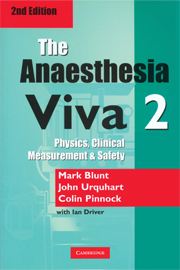Book contents
- Frontmatter
- Foreword to the First Edition
- Preface to the Second Editions
- Contents
- Physics, Clinical Measurement & Safety
- Clinical Anaesthesia
- Example 1
- Example 2
- 6 Example 3
- 7 Example 4
- Example 5
- Example 6
- Example 7
- Example 8
- Example 9
- Example 10
- Example 11
- Example 12
- Example 13
- Example 14
- Appendix 1
- Appendix 2
- Index
7 - Example 4
Published online by Cambridge University Press: 05 February 2015
- Frontmatter
- Foreword to the First Edition
- Preface to the Second Editions
- Contents
- Physics, Clinical Measurement & Safety
- Clinical Anaesthesia
- Example 1
- Example 2
- 6 Example 3
- 7 Example 4
- Example 5
- Example 6
- Example 7
- Example 8
- Example 9
- Example 10
- Example 11
- Example 12
- Example 13
- Example 14
- Appendix 1
- Appendix 2
- Index
Summary
Scenario
On your pre-operative ward round you visit an elderly lady who has come in for a knee replacement. She has suffered from rheumatoid arthritis for several years. What factors do you consider when making your assessment of her fitness for anaesthesia?
Rheumatoid arthritis (RA) affects 3% of the population, in a ratio of 3:1 Female:Male. It is therefore a common condition and many affected patients present for surgery and anaesthesia.
Rheumatoid arthritis has an insidious onset from the 4th decade of life onwards. Seropositive (IgM) RA is more common in people with HLA-DR4 than in the general population, and hence there is a genetic influence.
It is best to divide your answer into consideration of each physiological system in turn.
Cardiovascular considerations
10% have a pericarditis, which is often asymptomatic. 30% have a small pericardial effusion; rheumatoid nodules may form in the cardiac conducting tissues. The vasculitis may cause Raynaud's phenomenon and nail bed, cranial, coronary and mesenteric infarcts. There is a chronic anaemia (a haemoglobin of 10 g/dl is common), which correlates inversely with the erythrocyte sedimentation rate (ESR). This is worsened by the inevitable non-steroidal anti-inflammatory drug (NSAID) therapy these patients are prescribed.
Respiratory considerations
Pleural rubs, nodules and effusions are common, but rarely serious. Parenchymal disease is common if you look for it, but fibrosing alveolitis develops in only 2%, although it has a poor prognosis.
- Type
- Chapter
- Information
- The Anaesthesia Viva , pp. 92 - 95Publisher: Cambridge University PressPrint publication year: 2003

